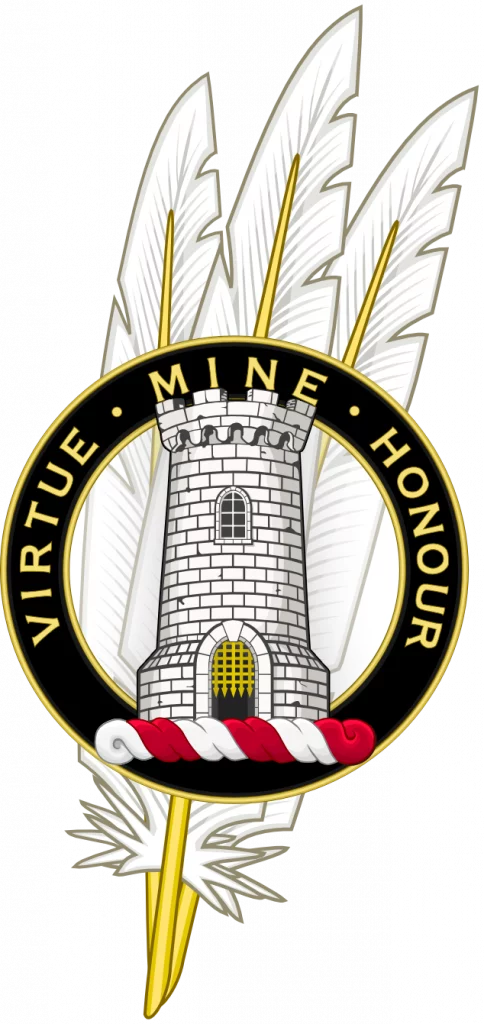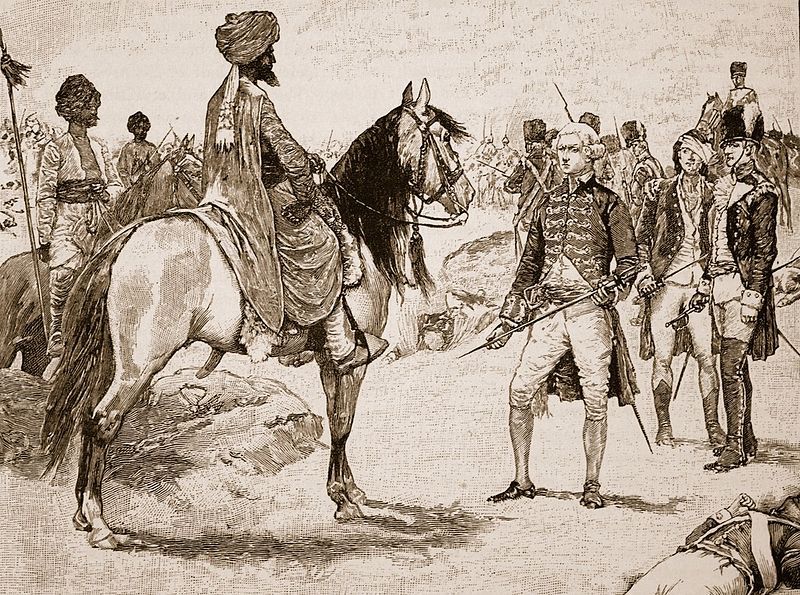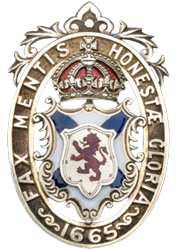
23th Chief, 7th Baronet of Morvern, 19th Laird of Duart, 3th Lord Maclean*
Lieutenant Sir Hector Maclean, 7th Baronet of Duart,1 3rd Lord Maclean2 became the 23rd Chief of the Clan Maclean on the 10th of December in 1783.1 When the 22nd Chief died without a male heir,3 the line of hereditary succession had to be traced back four generations to Hector Og.1 As the great-grandson of Hector Og’s1 third-born son, Donald Macleans of Brolas, Sir Hector was legitimate heir to the baronetcy and chiefship of his clan though.
The timing of his military service twice put his at key turning points in history. He participated the American Revolution, and saw the beginning of the end of the British East India Company’s hold on India.
Sir Hector was a private man by all accounts. There are remarkably scarce sources to highlight his life and fingerprint on history. Little is known of Sir Hector as he lived a quiet secluded life after retiring from military service.
Service
c 1782 Ensign, British Army, 84th Regiment of Foot4
1784 Lieutenant, British Army, 100th Regiment of Foot4
Honors
1783 7th Baronet of Morvern5
3th Lord Maclean*2
Family
Sir Hector was born to Donald Maclean of Brolas1 and Mary Dickson of Glasgow.2 Though the date of his birth is not recorded, Sir Hector was most likely sometime in the 1760’s. Mary died before having other children, and Donald married Margaret Wall of Clonea Castle in Waterford.6 Sir Fitzroy’s second great-grandfather was Donald Maclean, 1st Laird of Brolas and the third-born son Hector Og Maclean of Duart.2 Though Sir Fitzroy was married, he died before having any children.3
Military Service
The dates that bookend Sir Hector’s service in the British Army have long been forgotten. However it has been recorded that he was “sometime a Lieutenant”1 indicating that he held the rank longer than normal and that it was his final rank. The London Gazette does record that he purchased his commission as Lieutenant and transferred from the 1st Battalion of the 84th Regiment of Foot to the 100th Regiment of Foot on the 8th of May in 1784.4
American Revolution
At the time Sir Hector joined it, the 84th Regiment of Foot (Royal Highland Emigrants) was headquartered at Fort Edward in Nova Scotia. Though it was raised to defend British territories in Candada, the 84th saw offensive action during the American Revolution. Sir Hector’s distant cousin, Sir Allan Maclean of Torloisk raised the 84th and commanded its 1st Battalion. Consisting mainly of veterans of the Seven Years War, the 84th Regiment was one of the most seasoned officers corps in North America.7 Despite entering service near the end of the war, Sir Hector would have participated in the Battle of the Combahee River in August of 1782 near what is now Beaufort, South Carolina.8 His regiment departed the area with the British evacuation of Charleston a few months later. The 84th Regiment of Foot was raised on the North American continent where it mostly remained until it was disbanded in 1783 following the American Revolutionary War.9
Second Anglo-Mysore War
Hostilities of the American Revolution spilled into other areas of the world. The Kingdom of Mysore in Southern India was closely allied with the French. The British East India Company raised troops and funded their war with Mysore, which was endorsed and ultimately had to be reinforced by the British government when the French government began sending troops to aid Mysore.10
Five months before the 84th disbanded, Sir Hector purchased a commission as Lieutenant and transferred to the 100th Regiment of Foot. The three years before Sir Hector’s joined the 100th Regiment in India, it assisted in capturing the Cape of Good Hope from the French.11 The regiment went on to India to reinforce the 73rd Regiment of Foot and the British East India Company’s campaign to conquer Southern India in the Second Anglo-Mysore War. Despite initial successes, the two armies found themselves capturing and re-capturing the same territory. The breaking point came when Tippoo Sultan’s forces had laid siege to the British garrison at Mangalore. Despite facing a force 40 times large, the officers and men of the 73rd and 100th Regiments held out for 4 months before surrendering.
As neither side was positioned to break the stalemate, the Treaty of Mangalore was agreed to on March 11 of 1784, ending the war. The terms restored all lands to the status quo before the ware began.11 It would be another 15 years before the British would conquer India. The treaty was seen by many as the beginning of the end of the British East India Company, and led to the Pitt’s India Act.10

Sir Hector probably arrived in India just before the Treaty of Mangalore was signed. The 100th Regiment was stationed at Bombay and Madras for the duration of its time in India. The majority of the regiment returned to England in October of 1785 with the rest joining them in March of 1786. The 100th Regiment of Foot was disbanded in November of 1785; the officers were placed on half-pay and the men given a bounty of 14 days’ pay.11 As there is no record of his retirement, it is plausible that Sir Hector retired upon his return to England.
Retirement
Though his early life was spent in the Army, after resigning his commission Sir Hector spent the rest of his life in a quiet secluded retirement.1 Sir Hector died in York on the 2nd of November in 1818.2 Leaving no heirs, the baronetcy and chiefship fell to his half-brother, Sir Fitzroy Maclean.12


References
* Lord Maclean of the Jacobite Peerage
- Maclean, J. P. A History of the Clan MacLean from Its First Settlement at Duard Castle, in the Isle of Mull, to the Present Period. Cincinnati: R. Clarke, 1889. 230-231. Print. ↩︎
- The Jacobite Peerage, Baronetage, Knightage and Grants of Honour. T.C. and E.C. Jack: Edinburgh, 1904. p102. ↩︎
- Hoey, Brian. MacLean of Duart: The Biography of ‘Chips’ Maclean. Twickenham: Country Life, 1986. Print. p169-170. ↩︎
- “Issue 12541.” The London Gazette 8 May 1784: 2. Print. ↩︎
- Dod, Robert P. The Peerage, Baronetage and Knightage of Great Britáin and Ireland for 1863 Including All the Titled Classes Twenty – Third Year. Whittaker and Company, 1863. p393. ↩︎
- Gentleman’s Magazine. Vol. 29. London: John Bowyer Nicholas and Son, 1848. p84. ↩︎
- Stacy, Kim (1994). No One Harms Me With Impunity – the History, Organization and Biographies of the 84th Highland Regiment (Royal Highland Emigrants) and Young Royal Highlanders during the Revolutionary War 1775-1784. Unpublished manuscript. ↩︎
- Snowden, Yates; Cutler, Harry Gardner, eds. (1920). History of South Carolina. Lewis Publishing Company. p. 438. ↩︎
- Duncanson, John, Rawdon and Douglas: Two Loyalists Townships in Nova Scotia. Ontario: Mika Publishing Company, 1989. p60. ↩︎
- Tzoref-Ashkenazi, Chen (June 2010). “Hanoverians, Germans, and Europeans: Colonial Identity in Early British India”. Central European History. 43 (2): 222. doi:10.1017/S0008938910000014. JSTOR 27856182. ↩︎
- Baldry, W. Y., and A. S. White. “DISBANDED REGIMENTS. The 100th Foot.” Journal of the Society for Army Historical Research, vol. 1, no. 5, 1922, pp. 205–11. JSTOR, http://www.jstor.org/stable/44219136. Accessed 29 Dec. 2023. ↩︎
- (McLean, A. Sinclair. The Clan Gillean. Haszard and Moore: Charlottetown, 1899. Print 471-472. ↩︎
Article updated 2015 FEB 25
